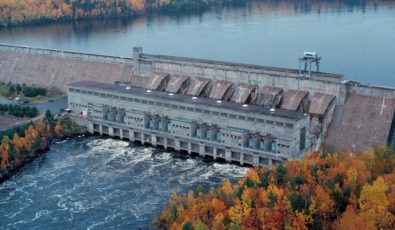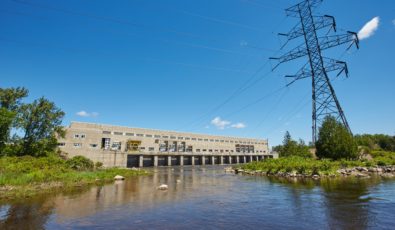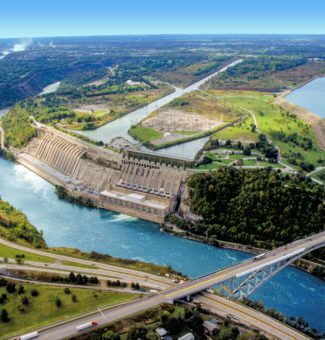Des Joachims and Chenaux hydro stations celebrate 70 years of clean power
In eastern Ontario, two major hydro stations are marking their 70th year of generating climate change-fighting power for the province.
For seven decades, Des Joachims Generating Station (GS) and Chenaux GS have been harnessing the waters of the Ottawa River to produce reliable, low-cost, clean electricity.

First placed into service in 1950, these two stations were part of the province’s great hydro expansion effort following the Second World War. To produce more electric power for Ontario’s homes, farms and industries, OPG’s predecessor, Ontario Hydro, looked to the Ottawa River to build a series of new hydro developments.
Situated deep in the Ottawa Valley between Quebec and Ontario, the 430-megawatt, eight-unit Des Joachims GS is the fourth-largest station in OPG’s hydro fleet and the largest on the Ottawa River. The station was officially opened on June 28, 1950, by then-Ontario Hydro chairman, Robert H. Saunders, and the late Ontario Premier Leslie Frost.
It also carries a unique nickname. The station’s original French name, pronounced “day-swa-shem,” was the name of a family who owned great tracts of land in the district.
Over time, Des Joachims evolved to “Da Swisha” – the efforts of the local English population trying their best to pronounce the French name – and it’s the moniker that has stuck.
“Chenaux has been producing green energy for the local area and the people of Ontario for a very long time. It’s a proud legacy and the station continues to operate very well.”Chris Hamel, Work Centre Manager at Chenaux GS
“This site was built with pride and, walking through the station, you can’t help but feel proud to know that this site has powered this province for seven decades,” said Mike Woodcock, Work Centre Manager at Des Joachims GS. “Through a rigorous maintenance program and the dedication of staff, the station is running well.”
During peak construction on the station, more than 3,100 workers were employed. A total of 672,848 cubic metres of concrete went into building the massive station, enough to pave a standard one metre-wide sidewalk across Canada.

Over the last 12 years, there has been a large capital investment in the station to keep it in top shape, Woodcock said. The plant has seen all of its turbines upgraded, new transformers installed, generators rewound, and all of its electrical equipment replaced.
The station is also undergoing a facelift of sorts, with a large concrete rehab project underway on its dam structure.
In addition to providing clean power throughout the years, Des Joachims GS was pivotal in providing electricity to support the early research and development of nuclear power in the Ottawa Valley.
Meanwhile, 96 kilometres downstream sits the 144 MW, eight-unit Chenaux GS.
Like Des Joachims, Chenaux’s name also has French roots.
Several hundred years ago, intrepid French-Canadian voyagers making their way down the Ottawa River to the flourishing fur markets in Montreal undertook a long portage just above the swift rapids. They gave the rapids the name Chenaux, plural for “chenal” or “channel.”
Fearing the loss of their precious furs in the seething waters, they favoured the safer course offered by the rigorous trail through the wilderness. The arduous portage was called “Portage du Fort” (portage of the strong), from which the nearby village derives its name.
About 1,100 construction workers were involved in building the station, which includes a powerhouse flanked by a 274-metre-wide main dam as well as two other control dams, one of which extends to the Quebec mainland. The estimated cost of the project at the time was $28 million.
Today, the run-of-river station has about 22 employees supporting it, from mechanics to project managers. Most of the station’s auxiliary systems have been upgraded or replaced over the years to introduce newer, more efficient technologies.
In the coming years, a number of Chenaux’s sluicegates, which control water flow, will be upgraded and renovated. A complete overhaul of the plant’s units is also scheduled to begin in about 10 years.
“Chenaux has been producing green energy for the local area and the people of Ontario for a very long time,” said Chris Hamel, Work Centre Manager at Chenaux GS. “It’s a proud legacy and the station continues to operate very well.”
Subscribe and stay informed
Sign up to receive the latest news, project updates, and event information from OPG.


